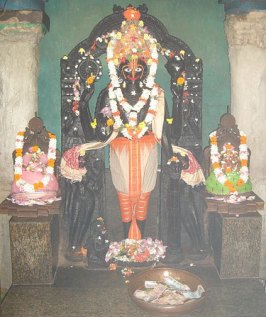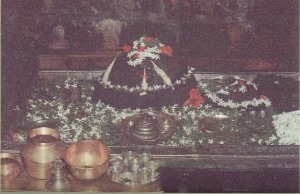Dear Fiends ,
It has been a while since adiyen has got the opportunity of witnessing a ‘ther’ or chariot procession. Such an opportunity presented itself today!
Today was the temple ther/rath yatra of Sri Jagannath of Puri, Orissa. The event was being telecast live on Doordarshan and was running for close to 7 hours. The Puri Jagannath temple rath yatra consists of 3 rathas - one each for Balabhadra (Balarama), Subhadra and Sri Jagannath. It was interesting to witness an elaborate ritualistic ceremony, including a slow rythmic carrying of deities into the ratha, the arrival of the king – ‘Gajapati Maharaj’ in a palanquin and a ritualistic broom sweeping done by him for all the 3 rathas (legend has it that an earlier king of Puri was protected by Krishna and Balarama themselves in a battle against the king of Kanchi). The procession then began with the traditional Oriya drums playing out loud. There was literally a sea of humanity out on the streets witnessing the sequence of the procession, with Balabadra followed by Subadra, and finally the pulling of Sri Jagannath’s ratha.
The Puri Jagannath temple is one of its kind with the inclusion of deities of Sri Krishna’s siblings – Subhadra and Balabhadra. The temple is recognised as one of the ‘char dhams’ or four important places of pilgrimage as identified by Sri Adi Sankara. The other three identified by him include – Badrinath, Dwarka and Rameswaram.
The live telecast also featured a section on another temple known as Alalnath – originally known as Alwarnath. I had not heard of this temple before, and was surprised that this temple had a significant connection with our Udayavar, Sri Ramanuja.
Adiyen will try and enlist some of the events, not necessarily in sequence, of Sri Ramanujar’s time at Puri and thereabouts. These incidents are based on reading up of several documents and may not be accurate in occurrence.
Sri Ramanujar goes to Puri
Sri Ramanujacharya’s visit to Orissa occurred at a stage in his life when his divnity was well known and he had countless followers. He was at the prime of efforts in holding the flag of Sri Vaishnavism high. He made several trips to holy places in the north of India including Kashmir. It was during one of these trips that he visited Puri, Orissa.
A north-Indian temple named after Azhwars!
While adiyen does not know the exact sequence of events, some time during his trip to Puri, Sri Ramanujar visited a place located some 28 kms south of Puri, known as Brahmagiri. It is said that during Satya Yuga, Brahma performed great tapas on Vishnu, and Vishnu pleased with the worship instructed Brahma to construct a temple here with a standing pose of Vishnu. This place came to be known as Brahmagiri. It is said that Sri Ramanujar visited the temple during his Orissa visit. He must have been delighted to see a beautiful deity of a four armed Sri Maha Vishnu, with conch, discus, mace and lotus flower. It is also believed that he named the deity ‘Sri Alwarnath’ or the ‘lord of the alwars’. As we know, the alwars/azhwars were the divine saints of Sri Vaishnava Sampradaya. The place which housed Alwarnath hence also came to be known as Alwarpur. And today the words have been shortened with time, the temple known as Sri ‘Alarnath’ or ‘Alalanath’ and the place called ‘Alarpur’!
There is more to the history behind Sri Alarnath temple connected to Vaishnavite traditions, which I shall explore in another post.
Sri Ramanujar establishes the Embar Mutt at Puri
On reaching Puri, Sri Ramanujacharya began to interact with the local priests and scholars. His natural brilliance attracted people and soon he found a crowd of devotees following in his foot steps. He decided to establish a monastery to be headed by Sri Govinda (his cousin). Govinda was also fondly called Embar by Emperumaanar, hence the mutt came to be known as ‘Embar mutt’.
Today the monastery is known simply as ‘Emar mutt’. The Emar mutt is located right outside the Puri Jagannath temple.*
Sri Ramanujar and the king of Puri
Emperumaanar had many meetings with the king, holding religious discussions with him. ‘Ananta Varman Choda Ganga Deva’ (Chodaganga) was the king at that time, who earlier had a leaning towards Saivite philosophy. The king developed a strong belief in Vaishnavism in his later years, during which time he had the opportunity of meeting Sri Ramanuja. The king was impressed by his preachings and deep knowledge of Vedic literature. It is believed that king Chodaganga grew deeper in his faith in Vaishnavism by the devotion and brilliance he witnessed in Sri Ramanujacharya.
Sri Ramanujar and Puri Jagannath mandir
Sri Ramanujacharya had a deep interest in establishing proper temple worship procedures wherever he went. He strongly believed in the Pancharatra Agama – school of temple worship, as followed at Sri Rangam. He desired to lay the foundations of the same style of worship in the Puri Jagannath temple. King Chodaganga eagerly supported this move. The temple priests came to know about Sri Ramanujacharya’s intentions and grew uncomfortable. They were very stiff in their opposition and were not ready to accept any changes in their earlier practices. During the night, the priests grew anxious and prayed to lord Jagannatha to prevent Emperumaanr from changing the customs followed by them. Lord Jagannatha in all his mercy decided to grant the priests their wish. While Emperumaanar was asleep, Sri Jagannatha appeared in his dreams and informed him that his current mission needed to be abandoned due to the requests of His devotees.
Meanwhile it is believed that a bunch of people wanted to eliminate Ramanujar and headed to where the Acharya was asleep. The Acharya was oblivious to the danger that was expected to befall him. They brandished their weapons ready to strike. And suddenly, Sri Ramanujacharya disappeared from sight right in front of them!
Sri Ramanujar magically transported to a town in Andhra!
With the rising sun the following day, Sri Ramanujar found himself transported several miles away from Puri, to a place near the town of Srikakulam in the present day Andhra Pradesh. Viewed in the perspective of how difficult it would have been for people to travel distances by foot or by cart in those days, the distance to which he had been transported overnight was phenomenal!It is said that Sri Jagannatha out of His kind mercy sent Garuda to transport Sri Ramanujar away from a problematic situation.
Emperumaanar was surprised to be alone in an unknown land and saddened by the separation from his loving disciples. However he could sense that he was in a divine sthala, and noticed that he was near a temple tank. He explored the temple to find out that the inner sanctum housed a black stone which seemed to be Linga. Sri Ramanujar was saddened further as he thought lord Jagannatha had in anger denied the Acharya a glimpse of His form in the temple. As the Acharya would not eat food not offered to the lord (Vishnu), he fasted that day. In his dreams the following night, Sriman Narayana revealed the true identity of the deity at the temple. Emperumaanar woke up the next day and was overjoyed! Lord Jagannath had not sent him here for nothing!
Sri Jagannatha informs Emperumaanar of His true form
The deity at the sanctum sanctorum was a swayambhu – or naturally occurring stone. It has a distinct shape, of the fossilised structure of a turtle. The lord appeared in the Acharya’s dreams to inform him that the deity was none other than the manifestation of the Kurma avatara of the lord. Sri Ramanujar also discussed it with the locals and was surprised to note that many of them already considered the stone as Sri Kurma, based on ancient stories. Even from a geological perspective, the temple is not too far from the sea, which supports the fossilised structure of a turtle theory. Interestingly there is also another stone – apaprently a Sudarshana-saligrama which had been placed earlier by Adi Sankara’s disciples at the tail end of the turtle-structure.
However, there was still a dispute in the village about the true identity of the deity. It is said that to convince everyone that it was indeed a manifestation of lord Vishnu, Emperumaanar asked the deity to turn towards him, towards the west. The deity did as was told! Hence another dwajasthamba or entrance pillar was constructed for the new direction in which the deity faced. This is one of the rare temples in which there are two dwajasthambas! There are more stories to this temple, which is a revered Abhimana sthalam for Sri Vaishnavas, which adiyen hopes to capture in another post.
Influence on Choddaganga and on Jagannath temple
Despite Sri Ramanujar’s sudden departure from Puri, the influence of his vision on Puri Jagannath temple remains. There is a shrine/sannadhi for Lakshmi built inside the compound of the Jagannath temple by Choddaganga, as suggested by Emperumaanar. The Puri temple is actually also known as Sri Mandira, in line with the belief that Jagannath is always with Lakshmi. There is also said to be considerable influence of Sri Ramanujar on other procedures, including the ther or rath yatra festival. King Choddaganga as a devotee remained singnificantly impacted by the teachings of Emperumaanar.
No matter what the form, or the manifestation – Lord Jagannatha or Sri Kurma – rest assured lord, we as devotees shall always drown in the beauty of your various forms as well as worship the divine feet of our Acharyas!
Azhwar Acharyargal thiruvadigale sharanam l
Srimathe Ramanujaaya Namah l
Srimathe Narayanaaya Namah l






No comments:
Post a Comment